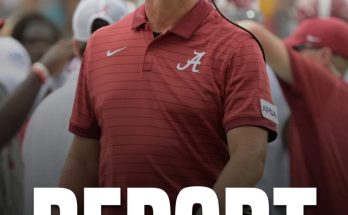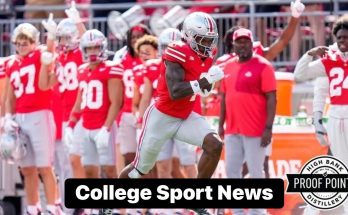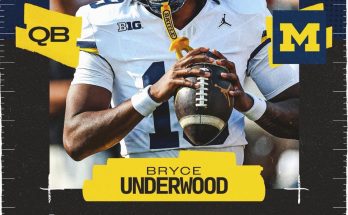In a move that has reignited the spirits of Texas A\&M football fans across the country, former Aggie legend and Heisman Trophy winner Johnny Manziel has officially returned to the university that helped launch him into the national spotlight. But this time, he’s not suiting up in pads or scrambling past defenders on a Saturday afternoon. Instead, Manziel has accepted a newly created position within the Texas A\&M football program—a role designed to bridge the past and present, to infuse leadership and mentorship into the current team culture, and to reinforce the identity of Aggie football in the modern era. His return is not just symbolic. It’s a calculated and deeply meaningful step in revitalizing the culture around the program, and more importantly, offering current and future players something Johnny Football never had: a direct line to someone who truly understands both the glory and the pressure that comes with being the face of Texas A\&M football.
Johnny Manziel remains one of the most iconic and polarizing figures in college football history. His impact transcends simple statistics and accolades. In 2012, as a redshirt freshman, he exploded onto the college football scene and did something that had never been done before: he won the Heisman Trophy as a freshman. Not only did he beat out older, more experienced players, but he also did so with a flair and energy that made him a household name across the country. Nicknamed “Johnny Football,” he quickly became the face of not just Texas A\&M football, but also of an era in which social media, highlight-reel plays, and quarterback improvisation started to reshape how we viewed the sport. That year, he threw for over 3,700 yards and 26 touchdowns while rushing for over 1,400 yards and 21 more scores. He led Texas A\&M to an 11-2 season, capped off with a resounding 41-13 victory over Oklahoma in the Cotton Bowl.
But Manziel’s legacy isn’t solely defined by that magical season. It’s also a story of adversity, media scrutiny, personal setbacks, and redemption. After a rollercoaster NFL career marked by controversy, unmet expectations, and personal battles with mental health and substance abuse, Manziel went through a long and winding road back to himself. What makes his return to Texas A\&M so powerful is that it’s not just a triumphant homecoming—it’s a full-circle moment grounded in reflection, growth, and a genuine desire to give back to the institution that gave him his first shot.
The university’s decision to create a new position for Manziel is not just a public relations move. It’s a testament to the administration’s recognition of the evolving needs of today’s college athletes. Today’s student-athletes navigate a complex world of media attention, NIL (Name, Image, Likeness) deals, mental health challenges, and the weight of expectations. Having someone like Manziel in the building—someone who has experienced all of those things and more—offers an invaluable resource to players, coaches, and even the wider community around the program. His new title, while still being formalized, reportedly includes elements of player engagement, alumni relations, brand development, and mentorship. It’s a hybrid role that plays to his strengths as a communicator, motivator, and someone who understands the Aggie culture inside and out.
From an educational standpoint, the hiring of Manziel is an extraordinary case study in how institutions can leverage the wisdom and experience of former players to build a more resilient and emotionally intelligent program culture. Too often, athletic departments focus solely on hiring individuals with pristine resumes or decades of coaching experience, neglecting the emotional intelligence and street-level wisdom that former athletes can bring to the table. In the case of Manziel, he not only brings name recognition and football knowledge but also a brutally honest perspective on the challenges players will face both on and off the field.
One of the most significant aspects of Manziel’s return is his focus on player development—particularly as it relates to personal growth, decision-making, and dealing with fame. In interviews following the announcement, Manziel has been candid about his own struggles during and after his college career. He has emphasized the importance of having mentors and mental health support, something he lacked during his meteoric rise. In his new role, Manziel intends to serve as a sounding board for players facing similar pressures. He’s not pretending to have all the answers, but he’s offering something far more valuable: experience and empathy.
Texas A\&M head coach Mike Elko, who recently took over the program, was instrumental in facilitating this new role for Manziel. In public comments, Elko noted that the program wants to emphasize character development as much as football success. Elko and Manziel share a vision of Texas A\&M as a school that not only competes for championships but also fosters leadership and accountability. Manziel’s charisma and relatability make him an ideal figure to reinforce that mission.
For young quarterbacks on the team, there may be no better mentor than Manziel. Despite all his flaws, his understanding of the game, especially improvisation under pressure, is world-class. He has an innate sense for reading defenses, extending plays, and taking advantage of broken coverages—skills that remain highly relevant in today’s fast-paced, spread-heavy college offenses. More than mechanics or playbook knowledge, Manziel can teach confidence, adaptability, and fearlessness. But perhaps even more important, he can offer cautionary tales of what not to do. His transparency about his off-field mistakes gives his advice an authenticity that no coach or sports psychologist can replicate.
There’s also a symbolic power to this move that can’t be overlooked. College football programs are built as much on tradition and legacy as they are on recruiting classes and game plans. The return of a legend—especially one as complicated and celebrated as Johnny Manziel—sends a strong message to alumni, fans, and recruits. It says that Texas A\&M is a place that takes care of its own, that believes in second chances, and that values the human beings behind the jerseys. That kind of messaging matters, particularly in a competitive recruiting landscape where players and families look closely at a school’s culture and long-term support system.
There are financial implications as well. Manziel’s presence around the program will undoubtedly boost fundraising efforts. Alumni events, speaking engagements, and promotional campaigns will now have a built-in draw. His name still resonates, especially with younger fans and those who fell in love with college football during his reign. And with the continuing evolution of NIL deals, having someone like Manziel involved in educating players about brand management and media strategy is incredibly forward-thinking. He knows better than anyone what it’s like to become a brand overnight—and the emotional toll that can take. His hard-won lessons can help prevent others from repeating the same mistakes.
Educationally, this also serves as a broader lesson in leadership development. Leadership is not about perfection; it’s about resilience, transparency, and the willingness to share one’s story to help others grow. Manziel’s transformation from a brash, controversial figure into a thoughtful mentor embodies the very essence of what universities should be teaching—growth through adversity, wisdom through failure, and strength through vulnerability. His story is not just about football. It’s about what happens after the final whistle, and how athletes can redefine themselves once the cheering stops.
Texas A\&M has also signaled that this will not be a ceremonial role. Manziel will be expected to attend practices, travel with the team, participate in recruiting events, and regularly meet with players and staff. There is even talk that he may eventually pursue a coaching role if this initial stint proves successful. That wouldn’t be surprising. Many former players who return to their alma maters in mentorship roles often find themselves drawn deeper into the coaching ranks. And with Manziel’s deep understanding of offensive football, especially in the context of college systems, his football IQ would be an asset to any sideline.
But even if he never calls a play or draws up a route, Manziel’s real contribution may be cultural. College football programs often struggle with cohesion between generations. Today’s players may have never seen Manziel’s 2012 highlights or fully grasp the frenzy he inspired. His presence on campus offers a bridge between eras. It brings history to life and grounds the current team in a legacy of greatness that they can now touch, talk to, and learn from.
Moreover, this could be a launching pad for other universities to create similar positions for former athletes. Many great players have fallen into obscurity or struggled with the transition after college or professional sports. Schools that actively create roles for these individuals not only tap into a wealth of knowledge and passion but also create a more holistic support system for current players. If successful, Manziel’s return to Texas A\&M could become a model for other Power Five programs looking to deepen alumni engagement and enhance player development.
In the end, the return of Johnny Manziel is a moment charged with symbolism, education, and redemption. It’s a reminder that sports are not just about wins and losses, but about people—complex, flawed, inspiring people—who shape and are shaped by the institutions they represent. Manziel’s journey has taken him through dizzying highs and devastating lows, but he returns to College Station not as a cautionary tale, but as a beacon of growth. His story is far from over, and this new chapter might be the most important yet. Texas A\&M has bet on Johnny Football once again—not to win games, but to win hearts, minds, and futures.
And this time, the stakes may be even higher.



